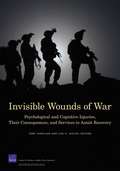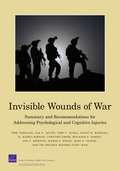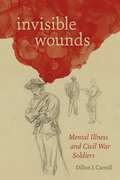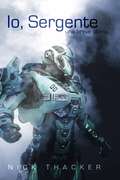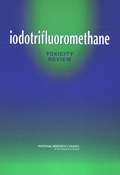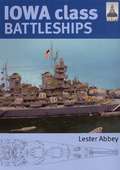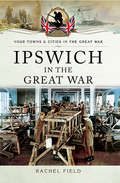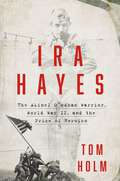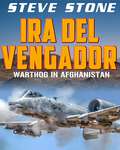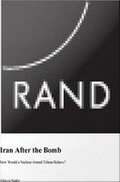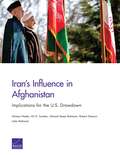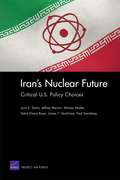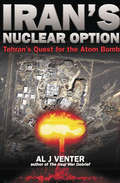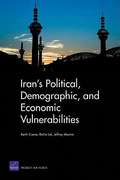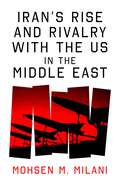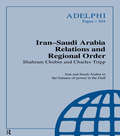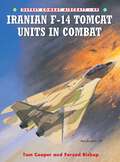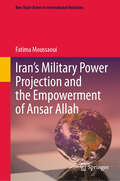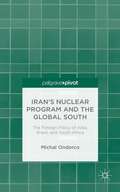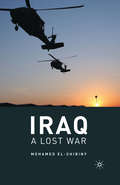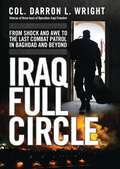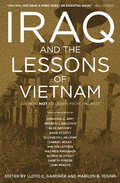- Table View
- List View
Invisible Wounds of War: Psychological and Cognitive Injuries, Their Consequences, and Services to Assist Recovery
by Terri Tanielian Lisa H. JaycoxSince October 2001, approximately 1.64 million U.S. troops have been deployed for Operations Enduring Freedom and Iraqi Freedom (OEF/OIF) in Afghanistan and Iraq. Early evidence suggests that the psychological toll of these deployments many involving prolonged exposure to combat-related stress over multiple rotations--may be disproportionately high compared with the physical injuries of combat. In the face of mounting public concern over post-deployment health care issues confronting OEF/OIF veterans, several task forces, independent review groups, and a Presidential Commission have been convened to examine the care of the war wounded and make recommendations. Concerns have been most recently centered on two combat-related injuries in particular: post-traumatic stress disorder and traumatic brain injury. With the increasing incidence of suicide and suicide attempts among returning veterans, concern about depression is also on the rise. The study discussed in this monograph focuses on post-traumatic stress disorder, major depression, and traumatic brain injury, not only because of current high-level policy interest but also because, unlike the physical wounds of war, these conditions are often invisible to the eye, remaining invisible to other servicemembers, family members, and society in general. All three conditions affect mood, thoughts, and behavior; yet these wounds often go unrecognized and unacknowledged. The effect of traumatic brain injury is still poorly understood, leaving a large gap in knowledge related to how extensive the problem is or how to address it. RAND conducted a comprehensive study of the post-deployment health-related needs associated with these three conditions among OEF/OIF veterans, the health care system in place to meet those needs, gaps in the care system, and the costs associated with these conditions and with providing quality health care to all those in need. This monograph presents the results of our study, which should be of interest to mental health treatment providers; health policymakers, particularly those charged with caring for our nation's veterans; and U.S. service men and women, their families, and the concerned public. All the research products from this study are available at http://veterans.rand.org. Data collection for this study began in April 2007 and concluded in January 2008. Specific activities included a critical review of the extant literature on the prevalence of post-traumatic stress disorder, major depression, and traumatic brain injury and their short- and long-term consequences; a population-based survey of servicemembers and veterans who served in Afghanistan or Iraq to assess health status and symptoms, as well as utilization of and barriers to care; a review of existing programs to treat servicemembers and veterans with the three conditions; focus groups with military servicemembers and their spouses; and the development of a microsimulation model to forecast the economic costs of these conditions over time. Among our recommendations is that effective treatments documented in the scientific literature, evidence-based care--are available for PTSD and major depression. Delivery of such care to all veterans with PTSD or major depression would pay for itself within two years, or even save money, by improving productivity and reducing medical and mortality costs. Such care may also be a cost-effective way to retain a ready and healthy military force for the future. However, to ensure that this care is delivered requires system-level changes across the Department of Defense, the Department of Veterans Affairs, and the U.S. health care system.
Invisible Wounds of War: Summary and Recommendations for Addressing Psychological and Cognitive Injuries
by Terri Tanielian Lisa H. Jaycox Grant N. Marshall M. Audrey Burnam Terry L. SchellSummarizes key findings and recommendations from Invisible Wounds of War: Psychological and Cognitive Injuries, Their Consequences, and Services to Assist Recovery (Tanielian and Jaycox [Eds.], MG-720-CCF, 2008), a comprehensive study of the post-deployment health-related needs associated with post-traumatic stress disorder, major depression, and traumatic brain injury among veterans of Operations Enduring Freedom/Iraqi Freedom.
Invisible Wounds: Mental Illness and Civil War Soldiers (Conflicting Worlds: New Dimensions of the American Civil War)
by Dillon CarrollDillon J. Carroll’s Invisible Wounds examines the effects of military service, particularly combat, on the psyches and emotional well-being of Civil War soldiers—Black and white, North and South. Soldiers faced harsh military discipline, arduous marches, poor rations, debilitating diseases, and the terror of battle, all of which took a severe psychological toll. While mental collapses sometimes occurred during the war, the emotional damage soldiers incurred more often became apparent in the postwar years, when it manifested itself in disturbing and self-destructive behavior. Carroll explores the dynamic between the families of mentally ill veterans and the superintendents of insane asylums, as well as between those superintendents and doctors in the nascent field of neurology, who increasingly believed the central nervous system or cultural and social factors caused mental illness. Invisible Wounds is a sweeping reevaluation of the mental damage inflicted by the nation’s most tragic conflict.
Io, Sergente
by Nick Thacker Cristina VentrellaIl mio nome è Renfro. Sergente Renfro o solo Sergente. Sì, Sergente è il mio nome di battesimo e si dà il caso che sia anche il mio grado. Sono nato dentro alla guerra e come conseguenza di essa, ma questa è un'altra storia. Il mio particolare interesse per l'arte militare ha rasentato lo zero per gran parte della mia vita, ma come tutti quelli della mia generazione, siamo stati trascinati sul campo.
Iodotrifluoromethane: Toxicity Review
by Subcommittee on IodotrifluoromethaneThe U.S. military is considering using a compound called iodotrifluoromethane (CF3I) for fire suppression to replace previously-used compounds (halons) that are being phased out because they deplete the ozone layer. This report reviews available toxicological data on CF3I and evaluates the scientific basis of the U.S. Army's proposed exposure limit of 2,000 parts per million (ppm). The report recommends that CF3I be used for fire suppression in normally unoccupied spaces because of its potential to cause cardiac sensitization in test animals. The report also recommends that further genotoxicity testing be conducted (testing for changes in genetic material), and that CF3I be assessed for its potential to cause cancer. Should the Army decide to use CF3I, information should be collected and evaluated on how much of the chemical or any of its degradation products might be released and how often.
Iowa Class Battleships
by Lester AbbeyThe 'ShipCraft' series provides in-depth information about building and modifying model kits of famous warship types. Lavishly illustrated, each book takes the modeller through a brief history of the subject class, highlighting differences between sister-ships and changes in their appearance over their careers. This includes paint schemes and camouflage, featuring colour profiles and highly-detailed line drawings and scale plans. The modelling section reviews the strengths and weaknesses of available kits, lists commercial accessory sets for super-detailing of the ships, and provides hints on modifying and improving the basic kit. This is followed by an extensive photographic gallery of selected high-quality models in a variety of scales, and the book concludes with a section on research references books, monographs, large-scale plans and relevant websites.The Iowa class were the largest, fastest and most modern US battleships of the war, and the formal surrender of Japan was signed on the deck of one of them, USS Missouri. Modernised post-war, they served in Korea, Vietnam and as late as the first Gulf War. They are among the most popular subjects of all for model kits.
Ipswich in the Great War (Your Towns & Cities in the Great War)
by Rachel FieldHow did children in Ipswich help the war effort? Who was imprisoned in Ipswich for opposing the war? Where in the town was there thought to be a German military control centre?In this thoroughly researched and highly readable study of the Ipswich Home F
Ira Hayes: The Akimel O'odham Warrior, World War II, and the Price of Heroism
by Tom HolmThe gripping, forgotten tale of Ira Hayes—a Native American icon and World War II legend who famously helped raise the flag at Iwo Jima but spent the latter half of his life haunted by being a war hero. IRA HAYES tells the story of Ira Hamilton Hayes from the perspective of a Native American combat veteran of the Vietnam generation. Hayes, along with five other Marines, was captured in Joe Rosenthal&’s iconic photograph of raising the stars and stripes on Mount Suribachi during the battle for the Japanese Island of Iwo Jima. The photograph was the inspiration and model for the U.S. Marine Corps War Memorial in Arlington. Between the time he helped raise that flag and his death—and beyond—he was the subject of more newspaper columns than any other Native person. He was hailed as a hero and maligned as a chronic alcoholic unable to take care of himself. IRA HAYES explores these fluctuating views of Ira Hayes. It reveals that they were primarily the product of American misconceptions about Native people, the nature of combat, and even alcoholism. Like most surviving veterans of combat, Ira did not think of himself as a heroic figure. There can be no doubt that Ira suffered from PTSD, which is a compound of survivor&’s guilt, the shock of seeing death, especially of one&’s friends, and the isolation brought on by feeling that no one could understand what he had been through. Ira&’s life has been a subject of two motion pictures and a television drama. All these dramas sympathize with him, but ultimately fail to see his binge drinking as his way of temporarily escaping the melancholy, the rage he felt, his sense of betrayal, and the sheer boredom of peacetime. IRA HAYES breaks apart the complexities of Ira&’s short life in honor of all Native veterans who have been to war in the service of the United States. This is equally their story.
Ira del vengador: Warthog in Afghanistan
by Steve StoneAvenger Wrath es la historia de un Hog Driver y su viaje durante la guerra en Afganistán, que opera desde la base aérea de Bagram con la hermosa, aunque mortal, cadena montañosa afgana como telón de fondo. El A-10 vio un uso casi constante en Afganistán, demostrando una vez más, como una plataforma de armas formidable y capaz. Esta versión revisada y actualizada del libro se ha vuelto más conmovedora ya que el F-35 tiene la oportunidad de demostrar que puede asumir el papel del A-10. El A-10 permanecerá en servicio hasta al menos 2022, con extensión de vida, quizás hasta 2040. Equipado con el GAU-8 Avenger, se descubrió que un cañón de 30 mm, diseñado para atravesar la armadura del tanque, era tan bueno para atravesar las gruesas paredes de barro de los complejos en los que los talibanes a menudo se refugiaban para montar emboscadas a las tropas de la coalición. Tiene una capacidad de supervivencia como ninguna otra aeronave actualmente en funcionamiento y ha llevado a su piloto de regreso a un estado que habría causado que otras aeronaves se hayan estrellado. Siga esta historia de alto octanaje basada en operaciones reales y obtenga una visión emocionante de un avión increíble.
Iran After the Bomb: How Would a Nuclear-Armed Tehran Behave?
by Alireza NaderThis study explores how a nuclear-armed Iran would behave and what this would entail for the United States and its main regional allies. It analyzes the Islamic Republic's ideology, motivations, and national security doctrine; examines a nuclear-armed Iran's potential policies toward Saudi Arabia and the GCC; discusses its potential behavior toward Israel; explores its relations with terrorist groups; and presents key findings.
Iran at War: 1500-1988
by Kaveh FarrokhIran's complex, violent military history encompasses two world wars, foreign intervention, anti-government revolts, border disputes, a revolution, a war against Iraq that lasted over eight years, and its desperate quest to become a nuclear power. Following his award-winning book, Shadows in the Desert, which explored the military history of ancient Persia, in Iran at War Kaveh Farrokh turns his attention to modern Iran's wartime history. Beginning with the Safavid dynasty of the 16th and 17th centuries, he traces Iran's political and military progress to its dramatic turning point in 1979. In doing so, Farrokh demonstrates how Iran's current bellicosity on the world stage was shaped by centuries of military defeat and humiliating foreign influences from the likes of Russia and Great Britain. Including illustrations and photographs, this book provides an unparalleled investigation into the bloody history of modern Iran.
Iran's Influence in Afghanistan: Implications for the U.S. Drawdown
by Robert Stewart Alireza Nader Ali G. Scotten Ahmad Idrees Rahmani Leila MahnadThis study explores Iranian influence in Afghanistan and the implications for the United States after most U. S. forces depart Afghanistan in 2016. Iran has substantial economic, political, cultural, and religious leverage in Afghanistan. Although Iran will attempt to shape a post-2014 Afghanistan, Iran and the United States share core interests: to prevent the country from again becoming dominated by the Taliban and a safe haven for al Qaeda.
Iran's Nuclear Future: Critical U.S. Policy Choices
by Lynn E. Davis Alireza Nader Dalia Dassa Kaye Jeffrey Martini James T. QuinlivanAs Iran's nuclear program evolves, U.S. decisionmakers will confront a series of critical policy choices involving complex considerations and policy trade-offs. These policy choices could involve dissuading Iran from developing nuclear weapons; deterring Iran from using its nuclear weapons, if it were to acquire them; and reassuring U.S. regional partners. The U.S. Air Force will need to prepare to carry out whatever policies are chosen.
Iran's Nuclear Option: Tehran's Quest for the Atom Bomb
by Al J. Venter“The most systematic exposition to date about Iran’s nuclear program and its role in world affairs” (Middle East Quarterly).Since the Islamic Republic of Iran admitted that it was secretly producing highly enriched, weapons-grade uranium, nations have struggled to react appropriately. For the first time, and in full detail, this book explains exactly what the Europeans and United Nations have been trying to forestall.Iran could shortly have the ability to strike its immediate Middle Eastern neighbors—and more distant nations—with nuclear weapons. With the size to dominate its region, Iran also has an avowed mission to export its theocratic principles, and in recent decades, has been a notorious supporter of terrorist organizations. Its parallel development of atomic bombs represents the greatest threat to the balance of world power we’ve seen in the new millennium.Here, defense expert Al Venter reveals the extent to which Iran’s weapons program has developed and the clandestine manner in which its nuclear technology has been acquired. He demonstrates how Tehran has violated the Nuclear Non-Proliferation Treaty and details the involvement of several countries shown by the IAEA to have trafficked in illegal nuclear materials. He proves, for the first time, a direct link between the now-defunct South African apartheid regime’s nuclear program and Tehran’s current nuclear ambitions.Venter digs deep into subjects such as Iran’s fervor on behalf of Shiite Islam, its missile program—developed alongside its nuclear one—and the role of the Pasdaran, the Revolutionary Guards, whose tentacles have spread throughout the Middle East and increasingly farther afield. While noting Tehran’s support of terrorist groups such as Hezbollah, Venter follows closely how the Persian homeland itself has progressed toward a strategic nuclear capability that would make recent terrorist attacks look obsolete. Iran’s Nuclear Option is essential reading for anyone with an interest in global security, the perilous volatility of the Middle East, and America’s options, should it be willing and able to counter the threat while time remains.
Iran's Political, Demographic, and Economic Vulnerabilities
by Keith Crane Rollie LalIran is one of the United States' most important foreign policy concerns. It has also been an extraordinarily difficult country with which to engage. Ironically, while the leadership has been hostile to the United States, Iranian society has evolved in ways friendly to the United States and U.S. interests. This monograph assesses current political, ethnic, demographic, and economic trends and vulnerabilities in Iran. For example, the numbers of young people entering the Iranian labor force are at an all-time high. The authors then provide recommendations for U.S. policies that might foster trends beneficial to U.S. interests. For example, greater use of markets and a more-vibrant private sector would contribute to the development of sources of political power independent from the current regime. The authors finally note a need for patience. Even if favorable trends take root, it will take time for them to come to fruition.
Iran's Rise and Rivalry with the US in the Middle East
by Mohsen M. MilaniThe 1979 Islamic Revolution triggered a cold war between Iran and the United States – former fast friends. Despite the US&’s relentless efforts at containment, Iran has risen as a formidable power in Iraq, Syria, Lebanon, Yemen, and Gaza. Its newfound status not only frustrates the US but has swiftly become a thorn in the side of Israel and Saudi Arabia. How did Iran rise so rapidly? And as it faces ever increasing pressure at home and abroad, can it hold onto its power? Mohsen Milani guides us through the twists and turns of the Iran–US rivalry in the battlefields of the Middle East. Going from the fall of the Shah to revolutionary Iran&’s alliances with Syria, Hamas, Hezbollah, Iraqi militias, and the Houthis in the Axis of Resistance, Milani lifts the veil on Iran&’s foreign policy strategy and its implications for the region, the US and Iran itself.
Iran-Saudi Arabia Relations and Regional Order (Adelphi series)
by Charles Tripp Shahram ChubinBoth countries will have strong incentives to test the artificial balance established by the US and from which they are excluded. Each state, in the face of continued embargoes, may find the lure of weapons of mass destruction correspondingly increased.
Irandam Ulagappor
by Pa. RaghavanA summary of events that led to the Second World War, the war that shook the entire world and the devastations it caused to the mankind, the role of Hitler in sustaining the war is well written and presents a fair protrayal in this book.
Iranian F-14 Tomcat Units in Combat
by Chris Davey Tom CooperSo formidable an opponent did the Iraqi airforce consider the F-14 that during the Iran-Iraq War (1980-1988), they ordered their pilots not to engage F-14s and the presence of one in an area was usually enough to empty it of Iraqi aircraft. Officially losses where tiny; only one F-14 was lost in aerial combat (to a MiG-21), one to a control problem and one downed by a ground-to-air missile. This book looks at the F-14's Iranian combat history and includes first hand accounts from the pilots themselves. It will consider key engagements and the central figures involved, illustrating the realities, successes and failures of the Iranian air campaign.
Iranian F-4 Phantom II Units in Combat
by Jim Laurier Farzad BishopDifferent versions of the jet have provided the backbone of the frontline strength of the Iranian air force since the 1970s, and whole generations of Iranian pilots and ground personnel have been trained to fly and maintain them. Indeed, the type bore the brunt of active combat operations during the long war with Iraq. Iranian F-4 Phantom IIs were also some of best equipped examples ever exported by the USA. Some Iranian Phantom II pilots gathered immense experience on the type, flying it in combat for more than ten years. This book removes the veil of secrecy surrounding Iranian Phantom II operations since the Iran-Iraq War (1980-1988).
Iran’s Military Power Projection and the Empowerment of Ansar Allah (Non-State Actors in International Relations)
by Fatima MoussaouiThe Islamic Republic of Iran, although it has become famous for its foreign policy choices and actions on the international scene, it remains an enigma for the West. This book provides an introspective analysis of the foundation of this unique Islamic state, and reveal what makes it resilient, and attempts to sustain it. Taking a multidisciplinary approach using anthropological, philosophical, psychological, and military grids, the book revisits the power of the clergy and maps out its original meaning and its ability to be wielded to serve policies in line with Iran's contemporary political context. This book will be of interest to students and scholars of military strategy, international security, and geostrategy, as well as military officers and policy makers who will benefit from the fresh perspective it adds to the Western view of a country whose strategic and military thinking is still largely unknown or misunderstood.
Iran’s Nuclear Program and the Global South: The Foreign Policy Of India, Brazil, And South Africa
by Michal OndercoThis book studies the reactions of India, Brazil, and South Africa the three main non-proliferation actors of the Global South to Iran's nuclear program. Their responses are explained and situated in wider foreign policy context.
Iraq
by Mohamed El-ShibinyIraq: A Lost War deals with the impact of September 11th on the occupation of Iraq and the U. S. declaration of war on international terrorism. It investigates whether war in Iraq was morally justified and whether coalition forces capturing and hanging its president were morally and legally acceptable internationally.
Iraq Full Circle
by Darron WrightCol. Wright served three tours of duty in the Iraq War, commanding the last active combat brigade to withdraw from Operation Iraqi Freedom. His book personalizes the broader operational conflict we've all heard so much about, giving us a previously unknown insider command perspective that will fundamentally change how our nation thinks of the war. For Col Wright, the Iraq war was a good war fought well. In his new book, Iraq Full Circle, he offers a first-hand assessment of the US Army's eight year war in Iraq.As battalion operations officer for an infantry battalion from 2003-2004 operating in the dangerous and volatile Sunni Triangle, followed by a tour of duty as a Brigade Executive Officer from 2005-2006 in Baghdad, Wright witnessed some of the harshest fighting seen during the war. He saw the evolution from 'shock and awe' to the 'clear-hold-build' strategy during the height of sectarian violence and was on-hand for the transition to COIN followed by the handover of security operations to the Iraqi Security Forces. In August 2010, Wright, as a deputy brigade commander, was among the last combat soldiers to leave Iraq as part of President Obama's draw-down of troops.While Wright does not hesitate to criticize the political and military leadership that failed to foresee the insurgency, or the errors in judgment that led to the dismantling of the Iraqi Army in 2003, his overall assessment of the war is that the US Army achieved what it was asked to do by two Presidents. Calling upon his experience--and the examination of thousands of after action reports, combat operations orders, and over 100 interviews--Wright pieces together a compelling and cohesive narrative of the war. Readers will be surprised to learn:· Wright had a strong hunch beginning in September 2001 that he would be deployed to Iraq; he and his fellow Army leaders began preparing for an invasion soon after the 9/11 attacks.· Army leaders were already implementing much of the COIN doctrine in 2004 and 2005, well before the official change in doctrine and the publication of the new field manual on COIN.· For Wright and most other leaders at his level, President Bush's troop "surge" in November 2006 was completely uncontroversial and utterly inevitable. They knew that clear-hold-build was the right strategy and would work but that they did not have enough troops to make it stick.In his closing chapters, Wright discusses the growth and evolution of the Iraqi Security Forces, from an abjectly corrupt and militarily useless cohort in 2004 to a well-trained and stable entity capable of securing Iraq and providing for (mostly) safe and open national elections in 2010. He finishes his narrative with his thoughts on the future of Iraq, understanding that sectarian divisions persist, but that the Iraqi Security Forces have been well-trained by the US Army to secure Iraq's future.From the Hardcover edition.
Iraq and the Lessons of Vietnam: Or, How Not to Learn from the Past
by John Prados Andrew J. Bacevich Christian G. Appy David Elliott Gabriel Kolko Alex Danchev Wilfried Mausbach Walter LaFeber Alfred W. McCoy Gareth Porter Elizabeth L. HillmanEssays by Christian G. Appy, Andrew J. Bacevich, John Prados, and others offer &“history at its best, meaning, at its most useful.&” —Howard Zinn From the launch of the &“Shock and Awe&” invasion in March 2003 through President George W. Bush&’s declaration of &“Mission Accomplished&” two months later, the war in Iraq was meant to demonstrate definitively that the United States had learned the lessons of Vietnam. This new book makes clear that something closer to the opposite is true—that US foreign policy makers have learned little from the past, even as they have been obsessed with the &“Vietnam Syndrome.&” Iraq and the Lessons of Vietnam brings together the country&’s leading historians of the Vietnam experience. Examining the profound changes that have occurred in the country and the military since the Vietnam War, this book assembles a distinguished group to consider how America found itself once again in the midst of a quagmire—and the continuing debate about the purpose and exercise of American power. Also includes contributions from: Alex Danchev * David Elliott * Elizabeth L. Hillman * Gabriel Kolko * Walter LaFeber * Wilfried Mausbach * Alfred W. McCoy * Gareth Porter &“Essential.&” —Bill Moyers
